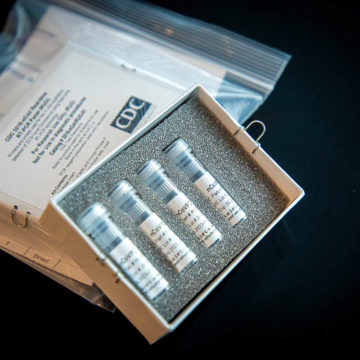Maintaining temperatures within a ‘safe zone’ during transportation is particularly important for medical goods that can experience changes to their chemical composition, if left in sub-optimum temperatures for too long. For example, when transporting Coronavirus samples taken from patients it’s important to maintain proper temperatures during shipment to avoid false-negative diagnosis of samples. Keeping kits within a temperature range of 2-8˚C during transportation and shipping overnight with an ice pack will save lives. ShockWatch recommends the ColdChain Complete and WarmMark product line to help ensure appropriate COVID-19 specimen shipping temperatures.
Looking after sensitive goods in these trying times is important. Regulations exist to ensure frozen and cooled goods are transported correctly, and these have only become stricter in recent times. For example, a food business must, when transporting food: protect all food from the likelihood of contamination, transport potentially hazardous food under temperature control and ensure that potentially hazardous food which is intended to be transported frozen remains frozen during transportation1. When sensitive biological goods are subjected to temperatures beyond a ‘comfortable’ range, proteins within the product can become cooked or frozen, nucleic acids can lose their effectiveness at transporting proteins, and sugars can cluster together, causing the product to lose its structural integrity. Strict temperature control must be maintained in the transport of biochemical goods and other biodegradable items too to omit the risk of these goods losing time on their shelf life or losing integrity, effectiveness or overall safety rating.
Foodstuff can become rotten if left too hot or lose their flavour and nutrients if frozen for too long. The changes in state listed above, when applied to medicinal products, can seriously reduce the effectiveness of medicine which puts lives at risk. Both medicinal goods and foodstuff can become harmful if exposed to temperature fluctuations the goods aren’t designed for. Temperature deviations can significantly or drastically change the molecular structures of biochemical products and might even speed up enzymatic activities that lead to degradation. Just like eating a rotten apple can give you a stomach ache, using medicine that has had its composition degraded can be useless or even dangerous.
There are methods to retain the structural integrity of sensitive goods during transportation, however the context of environmental variables during transportation must be explained before these methods are detailed. Notably, just because a temperature gauge reads ±0.5℃ at the end of a journey does not mean that this temperature was consistent throughout the entire trip. It’s important to use temperature recorders during transportation to know precisely what happens during transportation and storage. Temperature recorders can provide data that demonstrates if a product has been compromised at all during its journey and for how long said product was placed under thermodynamic pressure. Using temperature recorders and indicators provides third-party verification regarding a product’s successful delivery and its integrity at the end of its journey.
Here at ShockWatch we have temperature recorders and single-use temperature indicators with a 0.5 to 2℃ accuracy. Our temperature monitoring devices can be useful in temperature conditions ranging from -80°C to +37°C. We also have specific indicators that comply with the latest regulations on shipments. Many of our clients have used our indicators and recorders for their temperature-sensitive products, including biologics, food products, seafood, meat and dairy.
Contact us today for specific solutions so you can better ensure the integrity of your shipment. We even meet special requirements such as temperature, environmental and extreme environmental specifications.
- S, Estrada-Flores., Smale, N. & Tanner, D.J. 2006 Temperature Regulations during the Transport of Perishables in Australia. Food Science Australia – CSIRO. pp.81-89.


